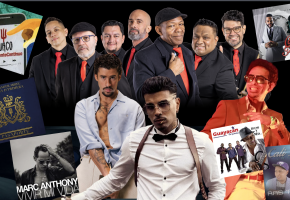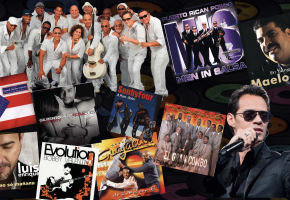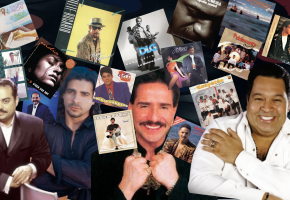1. Arsenio Rodriguez
The third of fifteen children, Cuban born Arsenio was blinded at the age of seven after a horse kicked him in the face. In 1938 he had his breakthrough hit Bruca Manigúa, which led him to form his own conjunto in 1940. ‘El Ciego Maravilloso’ (The Marvellous Blind Man), as he was known, developed the famed son montuno sound during the 1940s and 1950s – the basis of modern day salsa rythmns.
After a trip to New York to try to fix his vision in 1947, the artist composed his famed bolero La Vida es un Sueño. He remained in the city for a few more years, performing with other greats; Chano Pozo, Dizzy Gillespie and Mario Bauzá.
Claiming to be the true creator of the mambo, he was hit by the wane of the Latin music craze in the US. After trying to revive the genre in Los Angeles, he died in 1970. Without Arsenio, salsa would not be what it is today.

2. Tito Curet Alonso
Son of a music teacher, the Puerto Rican poet wrote his first song at 15 in 1941. Some of his childhood friends were Ismael Rivera, Daniel Santos and Rafael Cortijo. After studying journalism at university he developed his own unique style of “salsa with a conscience”, raising awareness of discrimination and xenophobia through his music.
Curet Alonso went on to write hundreds of songs, which were recorded by Salsa’s best known artists such as Tito Puente, Willie Colón, Hector Lávoe, Cheo Feliciano, Ismael Rivera, Celia Cruz and La Lupe. His songs became salsa’s biggest hits, including Cheo Feliciano’s Anacanoa, Periodico de Ayer sung by Hector Lavoe and Las Caras Lindas by Ismael Rivera.
Curet Alonso died of a heart attack in 2003, still working in the US postal service, receiving very few of the royalties he was owed. Despite dying in relative poverty, he was given a state funeral in his native Puerto Rico. His salsa anthems and street poetry are still sung today by salsa lovers all over the world.
3. Manny Oquendo
Born in 1931, Manny grew up in New York and began studying music in 1945. A talented musician of Puerto Rican ancestry, he began working in tropical latin bands such as “Chano” Pozo, Pupi Campo, Marcelino Guerra and José Curbelo.

His big break came in 1950 when he began working for Tito Puente as his bongo player, prior to working for Tito Rodríquez in 1954 and Vicentico Valdés in 1955. In 1962, he joined Eddie Palmieri’s ‘Conjunto la Perfecta,’ developing the New York style of the Mozambique rhythm.
In the 1970s he created ‘Conjunto Libre’ with Andy González, and with this band Oqendo would influence salsa for the next 20 years. Artists such as Hernan Olivera, Franky Vazquez, Jummy Bosch, Antony Carrillo, Richie Flores, Giovany Hidalgo and many other were part of it at one point.
Franki Dante
Baptised Lenin Francisco Domingo Cerda, after the Russian revolutionary leader, Dante preferred Italian Renaissance author for a stage name. Famed for his heeled boots and cowboy hat, Franki hit 1970s New York with his ‘Orquesta Flamboyan.’ Known for his over-the-top style and flamboyant mannerisms, the artist was an instant success.
His hits such as Vive la Vida Hoy, took a more political turn when he formed ‘Los Rebeldes’ in 1979, consisting of José Mangual, Ray Maldonado and Milton Cardona. Inspired by Rubén Blades, he developed his own version of spiritual salsa.
An extrovert to the end, Franki passed away in 1993. Some of his albums such at Beethoven's V (with pianist Marcolino Dimond) are considered some of the best ever recorded.
Perucho Torcat
One of Venezuela’s best loved salsa heroes was born in 1946. After trying to bring salsa to Caracas in 1965, with ‘Ray Pérez y su Charanga’, Perucho decided to form his own group ‘Los Dementes’ in his home state of Sucre.
The name for Perucho’s new group was inspired by his school music teacher’s musings that musicians should not play like ‘locos’. The group had hits with ‘Rómpelo’ and ‘Cuatricentinario’.
After a stint in New York, Perucho returned to his native Venezuela to record El Todopoderoso and Vamos a Reir un Poco later covered by Willie Colon and Hector Lávoe. He sadly passed away during his next trip to the States in 1972 in strange circumstances, right at the height of the city’s salsa boom.



















